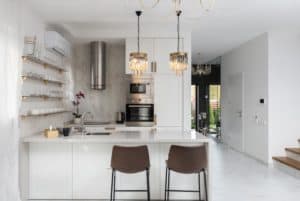One of the many aspects of describing furniture involves understanding the slight differences between two items that look very much the same! The furniture world is full, for example, of different designs of chairs. A chair is just a chair until you begin to look at the different styles across the ages, and realize that in fact one chair can differ considerably in design and construction from another.
This doesn’t just apply to chairs. In this article we’re talking about another form of seating, the stool. In particular, bar stools and counter stools. But wait: they’re the same thing, surely? A practical and simple form of seating that does not take up much space and can easily be stacked away out of sight?
You may think so, but in fact there are specific differences between the two. Let’s look at what defines a bar stool and how a counter stool differs, and then we’ll talk about which one may be a good choice if you want to give your home a new look.
What is a Bar Stool?
The bar stool is familiar to anyone who has ever entered a bar or pub. You’ll see them at the bar itself and by tables. These simple yet sometimes stylish designs, especially the retro ones, are popular with modern interior design projects. Also bar stools like these take modern design and manufacturing techniques and give the bar stool a look that is definitely of the moment, as well as attractive and practical.
So, a bar stool: what does define it? The bar stool is designed to support the sitter at a bar or table, and also to be put away under the table when not in use. The usual height of a bar is around 41” to 43”. This puts the ideal seat height for the comfort of the user at around 29” to 32”. A bar stool of that size will comfortably seat an average height person at an average bar, and fit underneath when not in use.
Now, as with counter stools – which we are about to talk about – the bar stool can also be an adjustable height item. This is common with modern metal designs (and also with many vintage designs) but not so much with the traditional type of standard wooden stool which will be supplied in a choice of heights. Now let’s consider the differences in a counter stool.
What’s Different about Counter Stools?
In furniture design there are many designations that can be confusing. For example, while we are talking about counter stools, others will refer to them as ‘counter height bar stools’. This is because the height of a bar and a counter is traditionally different. That’s what determines the difference between bar and counter stools.
A counter stool is designed for maximum comfort at a counter height of 35” to 37”. Compared to the bar height that is quite a big difference. The counter stool will have a seat height of between 23” to 28”. Now this leaves the sitter much closer to the floor than when on a bar stool.
The idea is that the corresponding stool, table, bar or counter are at the right height for either relaxing with a drink or eating a meal, depending upon what the user intends. Clearly, the counter stool will not be practical at the higher bar level, and vice versa. So, how did this come about, and what does it mean for when you are incorporating stools into your interior design?

Which is Best in the Home?
The evolution of the bar involved a modicum of security being built in. The height of a bar would originally been chosen for the safety of those behind it, and it has remained so ever since. There are of course bars at a lower height, but someone who is simply enjoying a drink while sat at a bar does not need the same flexibility as someone sat at a table eating a meal. The standards have been kept largely because bars today serve the same purpose as those of a couple of centuries ago, so the height of bar and counter stools remains relevant.
So, are you planning to incorporate stools into your interior furniture design? If so, are they going at a breakfast bar, or will they be used in conjunction with a table? The difference is that between choosing a bar stool or a counter stool, as we have explained above. Stools are, after all occasional seating and not for long duration (which was part of the design in the first place: they are not the most comfortable of seats!) The choice is yours but do remember to check the height of a table or bar before you match it with the best stools.
In Conclusion
Stools make a great addition to your furniture for occasional use, and especially if you are installing a breakfast bar. They are also useful on patios as outdoor seating, and as they come in many different shapes, styles and – as we have seen – sizes it’s worth planning your seating with additional stools involved to get the best out of perhaps limited space.
Check out the modern bar stools we gave you a link for earlier as they should provide you with inspiration for your room design, and put together a beautiful selection of furniture to be proud of.

Recent Comments